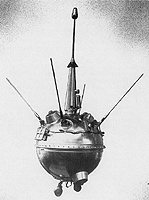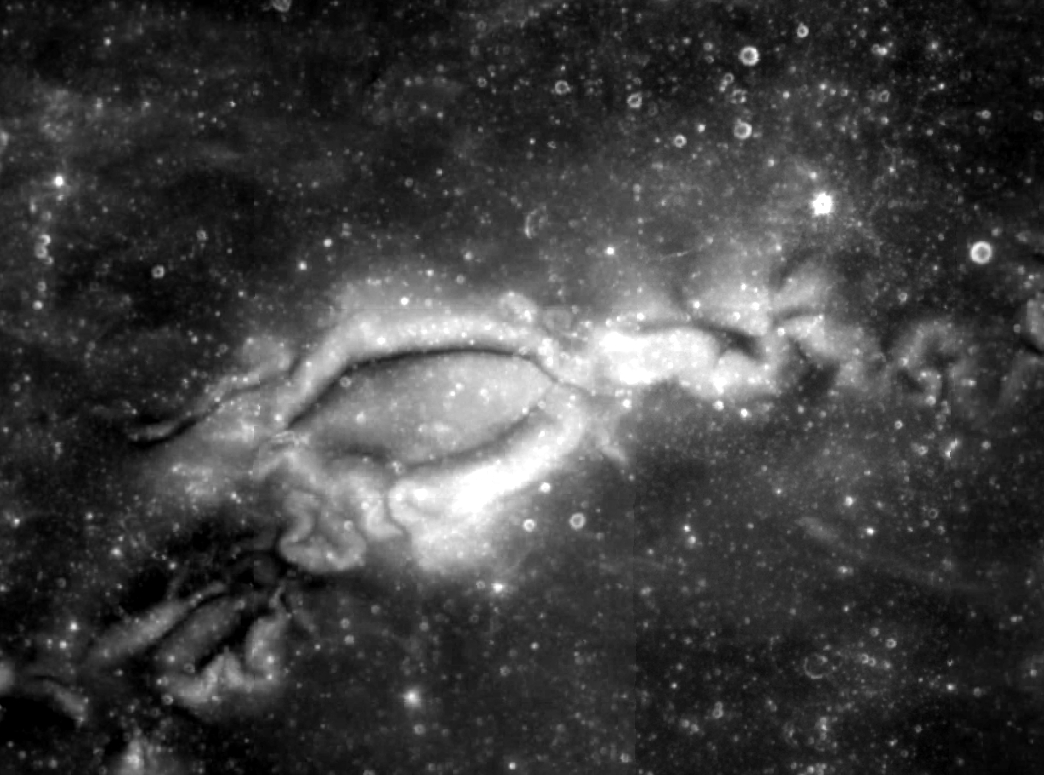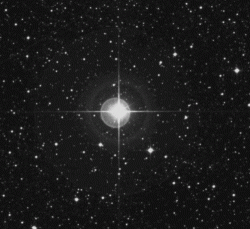Greetings, fellow SkyWatchers! It’s big… It’s bright. It’s undeniably the Moon. So what are we going to do this weekend? Why, study of course! We’ll take a look at some history, some mystery and even some cool variability that can be studied without any special equipment. Are you ready to journey into the night?
 Friday, September 12, 2008 – Arthur Auwers was born today in 1838. His life’s work included unifying the world’s observational catalogs. He specialized in astrometry, making very precise measurements of stellar positions and motions and he also calculated the orbits of Sirius and Procyon long before their companions were discovered. Auwers also directed expeditions to measure the transits of Venus and began a project to unify the all available sky charts, an interest that began with his catalog of nebulae which he published in 1862. There’s even a lunar crater named for him!
Friday, September 12, 2008 – Arthur Auwers was born today in 1838. His life’s work included unifying the world’s observational catalogs. He specialized in astrometry, making very precise measurements of stellar positions and motions and he also calculated the orbits of Sirius and Procyon long before their companions were discovered. Auwers also directed expeditions to measure the transits of Venus and began a project to unify the all available sky charts, an interest that began with his catalog of nebulae which he published in 1862. There’s even a lunar crater named for him!
 Also today, in 1959, the USSR’s Luna 2 became the first manmade object to hit the moon. It was the first spacecraft to reach the surface of the Moon, and it impacted the lunar surface west of Mare Serenitatis near the craters Aristides, Archimedes, and Autolycus. Scientifically, Luna 2 is most famous for confirming the earlier detection of the solar wind by Luna 1. However, it’s most famous for what it did after it launched! When it separated from its third stage, the spacecraft released a bright orange cloud of sodium gas, which aided in spacecraft tracking and acted as an experiment on the behavior of gas in space. Can you imagine the sight? Today also celebrates the 1966 Gemini 11 launch – the highest Earth orbit ever reached by an American manned spacecraft (1374 kilometer altitude).
Also today, in 1959, the USSR’s Luna 2 became the first manmade object to hit the moon. It was the first spacecraft to reach the surface of the Moon, and it impacted the lunar surface west of Mare Serenitatis near the craters Aristides, Archimedes, and Autolycus. Scientifically, Luna 2 is most famous for confirming the earlier detection of the solar wind by Luna 1. However, it’s most famous for what it did after it launched! When it separated from its third stage, the spacecraft released a bright orange cloud of sodium gas, which aided in spacecraft tracking and acted as an experiment on the behavior of gas in space. Can you imagine the sight? Today also celebrates the 1966 Gemini 11 launch – the highest Earth orbit ever reached by an American manned spacecraft (1374 kilometer altitude).
 Tonight our primary lunar study is crater Kepler. Look for it as a bright point, slightly north of lunar center near the terminator. Its home is the Oceanus Procellarum – a sprawling dark mare composed primarily of minerals of low reflectivity (low albedo), such as iron and magnesium. Bright, young Kepler will display a wonderfully developed ray system. The crater rim is very bright, consisting mostly of a pale rock called anorthosite. The “lines” extending from Kepler are fragments that were splashed out and flung across the lunar surface when the impact occurred. The region is also home to features known as “domes” – seen between the crater and the Carpathian Mountains. So unique are Kepler’s geological formations that it became the first crater mapped by U.S. Geological Survey in 1962.
Tonight our primary lunar study is crater Kepler. Look for it as a bright point, slightly north of lunar center near the terminator. Its home is the Oceanus Procellarum – a sprawling dark mare composed primarily of minerals of low reflectivity (low albedo), such as iron and magnesium. Bright, young Kepler will display a wonderfully developed ray system. The crater rim is very bright, consisting mostly of a pale rock called anorthosite. The “lines” extending from Kepler are fragments that were splashed out and flung across the lunar surface when the impact occurred. The region is also home to features known as “domes” – seen between the crater and the Carpathian Mountains. So unique are Kepler’s geological formations that it became the first crater mapped by U.S. Geological Survey in 1962.
Saturday, September 13, 2008 – Today in 1922, the highest air temperature ever recorded on the surface of the Earth occurred. The measurement, taken in Libya, burned in at a blistering 136° F (58° C) – but did you know that the temperatures in the sunlight on the Moon double that? If you think the surface of the Moon is a bit too warm for comfort, then know that surface temperatures on the closest planet to the Sun can reach up to 800° F (430° C) at the equator during the day! As odd as it may sound, and even as close to the Sun as Mercury is, it could very well have ice deposits hidden below the surface at its poles.
Get out your telescope, because tonight we’re going to have a look at a lunar feature that goes beyond simply incredible – it’s downright weird. Start your journey by identifying Kepler, and head due west across Oceanus Procellarum until you encounter the bright ring of crater Reiner. Spanning 30 kilometers, this crater isn’t anything showy…just shallow-looking walls with a little hummock in the center. But, look further west and a little more north for an anomaly – Reiner Gamma.
 Well, it’s bright. It’s slightly eye-shaped. But what exactly is it? Having no appreciable elevation or depth, Reiner Gamma could very well be an extremely young feature caused by a comet. Only three other such features are known to exist – two on the lunar far side and one on Mercury. They are high albedo surface deposits with magnetic properties. Unlike a lunar ray, consisting of material ejected from below the surface, Reiner Gamma can be spotted during the daylight hours – when ray systems disappear. And, unlike other lunar formations, it never casts a shadow.
Well, it’s bright. It’s slightly eye-shaped. But what exactly is it? Having no appreciable elevation or depth, Reiner Gamma could very well be an extremely young feature caused by a comet. Only three other such features are known to exist – two on the lunar far side and one on Mercury. They are high albedo surface deposits with magnetic properties. Unlike a lunar ray, consisting of material ejected from below the surface, Reiner Gamma can be spotted during the daylight hours – when ray systems disappear. And, unlike other lunar formations, it never casts a shadow.
Reiner Gamma is also a magnetic deviation on a barren world that has no magnetic field, so how did it form? Many ideas have been proposed, such as solar storms, volcanic activity, or even seismic waves. But the best explanation? It is the result of a cometary strike. Evidence exists that a split-nucleus comet, or cometary fragments, once impacted the area, and the swirl of gases from the high-velocity debris may have somehow changed the regolith. On the other hand, ejecta from such an impact could have formed around a magnetic “hot spot,” much like a magnet attracts iron filings.
No matter which theory is correct, the simple act of viewing Reiner Gamma and realizing it is different from all other features on the Moon’s Earth-facing side makes this journey well worth the time!
Sunday, September 14 – With a nearly Full Moon, skies are light-trashed tonight, so if you’d like to visit another object that only requires your eyes, then look no further than Eta Aquilae (RA 19 52 28 37 Dec +01 00 20), about one fistwidth due south of Altair…
 Discovered by Pigot in 1784, this Cepheid variable varies by over a magnitude in a period of 7.17644 days. During this time it will reach of maximum of magnitude 3.7, and then decline slowly over five days to a minimum of 4.5… Yet it only takes two days to brighten again! This period of expansion and contraction makes Eta unique. To help gauge these changes, compare Eta to Beta on Altair’s same southeast side. When Eta is at maximum, it will about equal Beta in brightness.
Discovered by Pigot in 1784, this Cepheid variable varies by over a magnitude in a period of 7.17644 days. During this time it will reach of maximum of magnitude 3.7, and then decline slowly over five days to a minimum of 4.5… Yet it only takes two days to brighten again! This period of expansion and contraction makes Eta unique. To help gauge these changes, compare Eta to Beta on Altair’s same southeast side. When Eta is at maximum, it will about equal Beta in brightness.
Wishing you clear skies and a super weekend!!
This week’s awesome images are Kepler Crater by Wes Higgins, Luna 2 courtesy of NASA, Reiner Gamma from the Clementine Lunar Browser and Eta Aquilae – Credit: Palomar Observatory, courtesy of Caltech. Many thanks!


Very nice article! Covers a wide span of themes, featuring each with just the right amount of detail to keep it in mind.
Reiner Gamma and Eta Aquilae will not be skipped by my attention any more.
Regards,
Günther
That Luna 2 is beautiful. In fact, it bears a striking resemblance to the imperial probe droid sent to Hoth in ‘Star Wars: The Empire Strikes Back’.
http://flickr.com/photos/8430189@N06/2307519680
Well, at least it does if you turn Luna 2 upside down.
This a wonderfull website I eally enjoyed it 🙂
Ya know what piss me off about this blog thingy. You’re a Day Late and a Dollar Short.
I get these emails about the weekend, after the weekend has gone by. I just got an email from universe today. No more then 15 minutes ago. The current date is Sept 16th 2008. What are you trying to do? Rub it in, ha ha ha you missed it…
FIX your email annoucement program! I am so close to canceling or removing myself from this crap…
Have a Nice Day!…